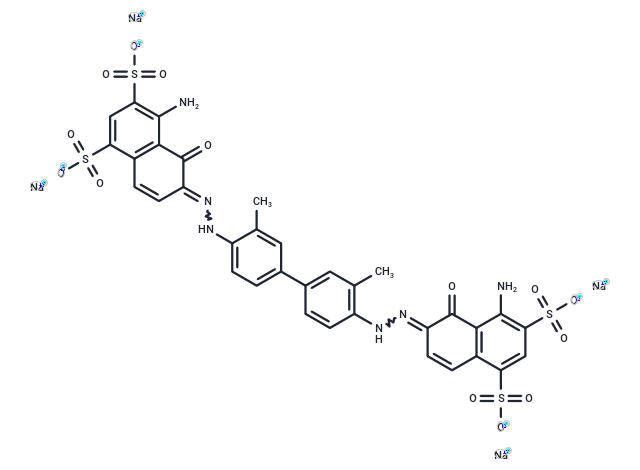Shopping Cart
- Remove All
 Your shopping cart is currently empty
Your shopping cart is currently empty

Evans blue (C.I. 23860) is an azo dye, inhibits L-glutamate uptake via the membrane-bound excitatory amino acid transporter (EAAT).

| Pack Size | Price | Availability | Quantity |
|---|---|---|---|
| 50 mg | $41 | In Stock | |
| 100 mg | $50 | In Stock | |
| 200 mg | $80 | In Stock | |
| 1 mL x 10 mM (in DMSO) | $57 | In Stock |
| Description | Evans blue (C.I. 23860) is an azo dye, inhibits L-glutamate uptake via the membrane-bound excitatory amino acid transporter (EAAT). |
| Targets&IC50 | Glutamate uptake (vesicular):87 nM |
| In vitro | Evans Blue is found to be inhibiting DNA binding of NF-κB at a low concentration of 100 μM[1]. It has proven over the years to be a dependable stain for microscopic determination of cell death[2]. Evans Blue is also a known blocker of a subset of a-amino-3-hydroxy-5-methyl-isoxazole/kainate receptors (IC50=355 nM) for the subunit combination GluR1,2[5]. Evans blue is the first known δ-subunit-specific antagonist of ENaC and activates large-conductance Ca2+-activated K+ channels in sheep bladder myocytes and cultured endothelial cells of human umbilical veins[5]. |
| In vivo | Evans blue pretreatment could inhibit the mast cells degranulation and that may be the main mechanism for prevent animals from C48/80-triggered anaphylaxis and systemic inflammation[4]. Evans blue modulates the non-N-methyl-d-aspartate receptor in rat thalamic neurons, blocks the P2X-purinergic receptor in rat vas deferens, and inhibits the glutamate transporter in rat brain synaptic vesicles[6]. |
| Alias | Direct Blue 53, C.I. 23860 |
| Molecular Weight | 960.78 |
| Formula | C34H24N6Na4O14S4 |
| Cas No. | 314-13-6 |
| Smiles | [Na+].[Na+].[Na+].[Na+].CC1=CC(=CC=C1NN=C1C=CC2=C(C(N)=C(C=C2S([O-])(=O)=O)S([O-])(=O)=O)C1=O)C1=CC(C)=C(NN=C2C=CC3=C(C(N)=C(C=C3S([O-])(=O)=O)S([O-])(=O)=O)C2=O)C=C1 |
| Relative Density. | no data available |
| Storage | keep away from direct sunlight | Powder: -20°C for 3 years | In solvent: -80°C for 1 year | Shipping with blue ice. | |||||||||||||||||||||||||||||||||||
| Solubility Information | H2O: 104.1 mM, Sonication is recommended. DMSO: 104.1 mM, Sonication is recommended. | |||||||||||||||||||||||||||||||||||
| In Vivo Formulation | PBS: 100 mg/mL (104.08 mM), Solution. Please add the solvents sequentially, clarifying the solution as much as possible before adding the next one. Dissolve by heating and/or sonication if necessary. Working solution is recommended to be prepared and used immediately. The formulation provided above is for reference purposes only. In vivo formulations may vary and should be modified based on specific experimental conditions. | |||||||||||||||||||||||||||||||||||
Solution Preparation Table | ||||||||||||||||||||||||||||||||||||
H2O/DMSO
| ||||||||||||||||||||||||||||||||||||

Copyright © 2015-2025 TargetMol Chemicals Inc. All Rights Reserved.